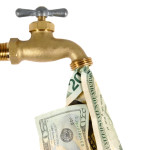 Profit is important because without it your business will fail. But for small businesses, cash flow is king. Your company’s cash flow will determine its profitability, and scrutiny of your business’ cash flow will increase your control over this dynamic. Follow these 4 cash flow tips to establish the structure you need to succeed.
Profit is important because without it your business will fail. But for small businesses, cash flow is king. Your company’s cash flow will determine its profitability, and scrutiny of your business’ cash flow will increase your control over this dynamic. Follow these 4 cash flow tips to establish the structure you need to succeed.
1. Know Your Balance Sheet
Many business people don’t understand how cash flow works and its significance to keeping their business operating. Focusing on the profit and loss statement is potentially a fatal mistake as healthy profits can mask an impending cash flow crisis. Profit and loss statements don’t usually contain the information required to make an adequate cash flow projection. What is need is a structured balance sheet that includes all the influencing items such as debts, interest payments, inventory and so on. You want to see the data that represents your cash flow and which can be employed to project the comings and goings of your cash over the period you have selected.
2. Set Up a Cash Flow Budget, Revise it Periodically, and Stick to It
Plan forward to generate a projection of likely future sales and expenses. You, or your accountant, can set up such a cash flow worksheet in Excel to automate this exercise.
Reviewing and updating your cash flow budget regularly is your best insurance against potential cash shortages. If your business has a predictable cash flow, then revising the cash flow budget on a quarterly basis is probably sufficient. But the greater the cash flow uncertainty a business has, the more frequently a new cash flow budget should be prepared.
If cash is tight, you may need to do to weekly projections, and decide which invoices you’ll pay and which customer payments you need to collect as soon as possible.
Rapid growth sounds good but, ironically, it can bring on a surprise cash crunch. Additionally, a sudden increase in sales often creates an inventory drop that can make the timely fulfillment of orders difficult. The extra time you spend managing your increased sales often takes up your time and results in debtors not being tracked or followed up on when their accounts become overdue. Strong sales one month often means a cash shortage next month. By monitoring the business’ cash status you can arrange credit from suppliers, banks and other sources such as factoring, to cover the temporary shortfalls.
Just like your company budget, you need to continuously reference your cash flow budget worksheet in order to drive your cash flow situation rather than become a casualty of it. So set that budget and stick to it. As your cash flow circumstances evolve you will need to revise that budget and adjust to the new level of cash management it will then require. Stay on top of your cash flow process.
3. Set Credit, Accounts Receivable & Accounts Payable Policy & Procedure as One Strategy
What credit you allow, how you monitor its use, how you manage the bills you pay, and how you pay the bills you owe, are the components of your cash flow process. How you coordinate them is what determines your actual cash flow, and often times the survival of your company.
Set Your Credit Policy & Terms
If the nature of your business requires offering credit, then it is important to set clear limits to your terms of credit.
Manage Accounts Receivable Strictly
Get payments in quickly. Master the art of debtor management. Let debtors know how much time remains before due dates. Stay in close touch with major debtors as payment deadlines approach. Offer small discounts for early payment as an incentive.
Pay Your Creditors Strategically
Take advantage of credit terms and prioritize payments according to the consequences involved in becoming past-due. Wages, taxes and direct debits are at the top of the list for on-time payment. Key suppliers may be prepared to wait to keep your business. Don’t pay early just to get a discounted price unless getting the discount is better than being without the cash.
Plan for Lean Times
Monitor your bank balances, be aware of when lean cash flow periods are coming up, and plan accordingly. Avoid funding major purchases from your business’ working capital unless you are sure you have the cash to cover it.
4. Get financial products working to your benefit
Overdrafts, premium funding, lease facilities and cash flow funding products such as factoring can all be excellent tools to help match cash supply with outlays. These arrangements take time to set up, so you need to be prepared in advance. In a pinch, the business credit card can be a good way to ease the crunch as long as it can be paid off before interest kicks in.
Of course there are other items that impede proper cash flow, and are important to avoid, such as:
- tax penalties
- non-budgeted purchases
- personal use of company monies
- making advances and loans to employees
- having un-deposited checks sitting on your desk
- not investing excess cash
- etc., etc., etc….
But the four major categories discussed above should be your first concern as they are the foundation for establishing control over your cash flow and the impact it has on your business’ profit, survival and growth.



